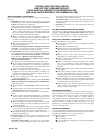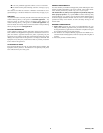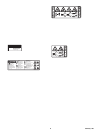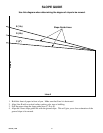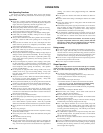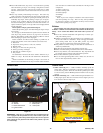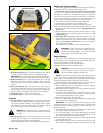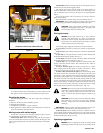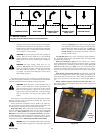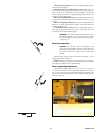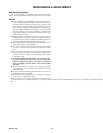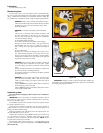
601156_1106 13
C. Deck clutch switch (Fig. 3-1) — this switch engages the deck. Pull the
switch up to engage and push switch down to disengage the clutch.
IMPORTANT: Never engage clutch with engine running at high rpm or
when the deck is under load. Clutch, belts or deck could be damaged.
D. Ignition switch (Fig. 3-1) — a three position switch: off, run, and start.
With key inserted, rotate it clockwise to START position; release key
when engine starts, and switch will automatically return to the RUN
position.
E. Oil pressure light (Fig. 3-1) — this light comes on when the ignition
switch is placed in the RUN position and stays lit until the engine is run-
ning and a safe oil pressure is developed. If light comes on during oper-
ation, shut engine off immediately and locate and correct the problem.
F. 20 amp fuse (Fig. 3-1) — Main - 20 amp, blade-type
G. 10 amp fuse (Fig. 3-1) — Clutch/Aux - 10 amp, blade-type
Controls
A. Steering control levers (Fig. 3-2 & 3-3) — these levers control the trac-
tor’s speed, direction, stopping, neutral lock, and park brake. Levers are
used to steer, accelerate, decelerate, stop and change direction. When
the control levers are in the park brake position (3-3) the tractor will not
move when the engine is on and drive pumps are operating.
WARNING: The parking brake may not hold the tractor if
parked on a slope. Block or chock the machine when parked
on a slope
B. Deck lift pedal (Fig. 3-4) — the deck lift pedal is used to raise or lower
the deck. Push on the pedal to raise the deck and then place the deck
height locking pin into the desired cutting height hole.
Push the deck lift pedal to raise the deck when going over obstructions.
Safety start interlock system
The tractor is equipped with a safety start interlock system consisting of
the park brake switches, seat switch, and deck clutch switch.
Check tractor safety start interlock system daily, prior to operation.
This system is an important tractor safety feature. It should be repaired
immediately if it malfunctions. The machine incorporates a separate seat
switch which will stop the tractor engine when the operator is unseated for
any reason while the tractor is operating. This is a safety feature designed to
prevent runaway or accidental entanglement. To inspect the system:
1. The operator must be on the seat when testing the seat switch.
2. Set both steering control levers in the park brake position.
3. Start the engine and allow it to warm up to operating temperature.
4. With the deck clutch switch down and the steering control levers in the
park brake position, slowly raise off of the seat. The engine should con-
tinue to run.
5. With the deck clutch switch up and/or the steering control levers in the
neutral, forward or reverse position, slowly raise off of the seat. The
engine should stop.
6. If the engine fails to stop when the deck clutch switch is up or one or
both of the steering control levers are up and the operator is off the seat,
check the function of the seat switch. If the seat switch is not operating
properly (is not opening or closing) and if the cause can not be deter-
mined, replace the seat switch.
If the problem can not be located, contact your Hustler Dealer.
WARNING: The safety interlock system should always func-
tion per steps 4 and 5. If it does not function properly, it
should be corrected immediately. Do not operate machine
without properly functioning seat safety switch.
Engine starting
The tractor’s safety start interlock system is also designed to protect the
operator and others from accidental injury due to unintentional engine start-
ing. The engine starting motor will not engage until:
A. Steering control levers are in the park brake position.
B. Deck clutch switch is in the down (OFF) position.
WARNING: The safety interlock system must not be discon-
nected or bypassed. Doing so could cause the machine to
operate unexpectedly resulting in personal injury.
NOTE: The operator’s seat is equipped with a separate safety switch. If
for any reason the operator should become unseated when the steering con-
trol levers are not in the park brake position (park brake switches are disen-
gaged) or the deck clutch switch is engaged the engine will stop.
The following steps are the correct procedures for starting the engine. If
difficulty is encountered, contact the Hustler Dealer in your area.
1. Before starting tractor each day, perform daily pre-operation checking.
(See Safety start interlock system section)
2. Make sure the steering control levers are in the park brake position and
deck clutch switch is disengaged.
3. Use choke, if unit is equipped with one, when engine is cold, or if warm
engine fails to start within 5 seconds of cranking. Avoid flooding and
operate engine without choking as soon as possible.
4. Set throttle at approximately 1/2 open position.
5. Insert key in ignition switch and rotate full clockwise to engage starting
motor. Release key when engine starts.
IMPORTANT: The engine starter should not be operated for periods
longer than 30 seconds at a time. An interval of at least two minutes should
be allowed between such cranking periods to protect the starter from over-
heating and burn-out.
6. Perform test to make sure safety start interlock system is operating prop-
erly. Refer to Safety start interlock system section.
7. As soon as engine begins to run, check to make certain the oil warning
light, engine light and alternator warning light (if applicable) are off. If
not, stop engine immediately and check for the cause.
8. Allow the engine to idle a few minutes before advancing the throttle and/
or engaging the deck clutch.
9. Before stopping the engine, place the steering control levers in the park
brake position, disengage the deck clutch, and throttle back to low idle
Figure 3-3
Figure 3-4
Steering control levers in
park brake position
Deck lift pedal



